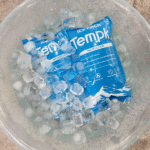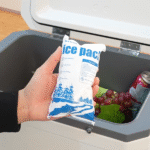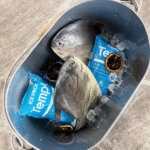Blocs de glace carbonique jetables pour l'expédition: Meilleures pratiques et tendances en 2025
Introduction:
Expédition de produits sensibles à la température, especially perishable goods, requires careful planning to maintain the right conditions. Disposable dry ice blocks are a reliable and efficient solution for this. Dans cet article, we will explore how disposable dry ice blocks work, the best practices for using them, and what trends are shaping the future of dry ice in 2025.

Why Should You Choose Blocs de glace carbonique jetables pour l'expédition?
-
Effective and Long-lasting Cooling: Dry ice blocks can maintain temperatures as low as −78.5°C (−109,3 ° F), Idéal pour les produits sensibles comme les produits pharmaceutiques, nourriture, et des échantillons biologiques.
-
Solution rentable: Disposable dry ice blocks are an affordable alternative to reusable coolers and gel packs, especially for short-term shipments.
-
Simplicity and Convenience: With no need for return logistics, these blocks provide a hassle-free solution for one-time shipments.
Key Benefits of Disposable Dry Ice Blocks
-
Maintains Extremely Low Temperatures: Dry ice blocks keep goods frozen for 24 à 72 heures, ensuring perishable items stay safe.
-
Pas d'eau de fusion: Contrairement aux packs de gel, which can cause moisture-related damage, dry ice sublimates directly into CO₂ gas, ne laissant aucun résidu d’eau.
-
Versatilité: Available in blocks, boulettes, and scored sheets, they can be selected based on shipment size and duration.
Real-world Example: A pharmaceutical company shipping vaccines reduced spoilage by 15% using disposable dry ice blocks, demonstrating their effectiveness in temperature-sensitive logistics.
Best Practices for Using Disposable Dry Ice Blocks
Proper handling and packaging are essential for optimizing the performance of disposable dry ice blocks. Below are the steps to follow:
1. Sizing Your Dry Ice Block
To ensure your shipment remains at the right temperature, it is crucial to calculate the amount of dry ice required:
-
Règle: Pour une période d'expédition de 24 heures, use 5–10 lbs of dry ice per box. Adjust based on insulation quality and ambient temperature.
-
Considérations: Longer shipments or hotter climates may require more dry ice to maintain optimal conditions.
Sizing Example
For a shipment of 10 kg of frozen seafood in a 15L insulated box, a 48-hour journey through moderate temperatures would require approximately 1.8 kg de glace sèche.
| Type d'expédition | Délai d'expédition | Dry Ice Requirement | Avantages |
|---|---|---|---|
| Fruits de mer surgelés | 48 heures | 1.8 kg | Ensures frozen goods arrive intact |
| Médicaments | 72 heures | 7.5 kg | Maintains ultracold temperatures and prevents spoilage |
2. Choisissez le bon emballage
Ensure that your shipment is well insulated. Use insulated containers that can withstand the cold temperatures of dry ice and prevent rapid sublimation. Consider using vacuum-insulated panels (VIP) ou polystyrène élargi (PSE) for better performance.
3. Safety and Disposal Considerations
Handling dry ice requires safety precautions:
-
Portez des gants isolés: To avoid frostbite.
-
Assurer une bonne ventilation: La glace sèche sublime dans le gaz co₂, which can accumulate in sealed containers and cause pressure build-up.
-
Élimination: Once the dry ice has sublimated, dispose of it in a well-ventilated area to avoid CO₂ buildup. Never dispose of dry ice in enclosed spaces or down drains.
Trends in Dry Ice Shipping for 2025
The cold chain logistics industry is evolving with new technologies and innovations in packaging materials. Here’s what’s driving the future of disposable dry ice blocks:
1. Smart Packaging and IoT Monitoring
Smart packaging solutions with IoT sensors are becoming increasingly popular, allowing real-time temperature tracking during transit. These systems help companies monitor and adjust shipments, reducing spoilage and improving reliability.
2. Pratiques durables
As demand for eco-friendly solutions grows, companies are turning to hybrid systems that combine dry ice with phase-change materials (PCMS) to reduce CO₂ emissions and improve cost-effectiveness.
3. Advances in Insulation Materials
New insulation technologies, tels que des panneaux isolés sous vide (VIP), are expected to reduce the need for large amounts of dry ice, improving the cost-efficiency of shipments and reducing environmental impact.
Règlements de sécurité et conformité
Shipping dry ice requires compliance with regulatory standards. Key guidelines include:
-
Lignes directrices de l'IATA: Packages containing dry ice must be labeled as “Dioxyde de carbone, Solide (Glace sèche), UN1845” and meet IATA Packing Instruction 954.
-
Règlements du DOT: La glace carbonique doit être emballée dans des conteneurs ventilés, and weight limits must be adhered to, typically no more than 5.5 lbs (2.5 kg) per package for air shipments.
Failure to comply with these regulations can result in delays and fines.
4. Cost and Sustainability of Disposable Dry Ice Blocks
Dry ice is often a more cost-effective solution compared to reusable coolers or gel packs for short-term shipments. Cependant, several factors can influence cost:
-
Achats en vrac: Buying dry ice in bulk can reduce unit costs.
-
Qualité de l'isolation: Upgrading insulation reduces dry ice consumption, saving costs in the long run.
-
Eco-Friendly Sourcing: Some suppliers are now using CO₂ captured from renewable sources, which helps reduce the environmental impact of dry ice production.
Practical Guidance
-
Negotiate with Suppliers: Secure long-term contracts to mitigate price fluctuations.
-
Invest in Better Insulation: Use high-quality insulation materials to minimize the amount of dry ice needed.
Common Questions About Disposable Dry Ice Blocks for Shipping
Q1: How long will disposable dry ice blocks keep my shipment frozen?
With proper insulation and packaging, disposable dry ice blocks can maintain frozen temperatures for 24-72 heures, depending on the size and conditions of the shipment.
Q2: How do I dispose of unused dry ice after shipping?
Once the dry ice has sublimated into gas, dispose of it in a well-ventilated area. Never dispose of it in an enclosed space.
Q3: How do I determine the amount of dry ice required for my shipment?
The general guideline is 5-10 lbs de glace sèche par 24 heures d'expédition. Adjust based on insulation, température ambiante, and the duration of the shipment.
Conclusion et prochaines étapes
Disposable dry ice blocks are an effective and cost-efficient solution for shipping temperature-sensitive products. By following the best practices outlined in this article, you can ensure safe, fiable, and cost-effective shipping.
Étapes suivantes:
Ready to implement dry ice blocks in your cold chain shipping? Contact us for a personalized consultation, and let’s optimize your logistics strategy.
À propos du tempk
Tempk is a leading provider of cold chain logistics solutions, specializing in dry ice blocks, packs de gel, et conteneurs isothermes. Our goal is to help businesses ship sensitive products safely and efficiently. Contact Tempk today to improve your shipping processes.























